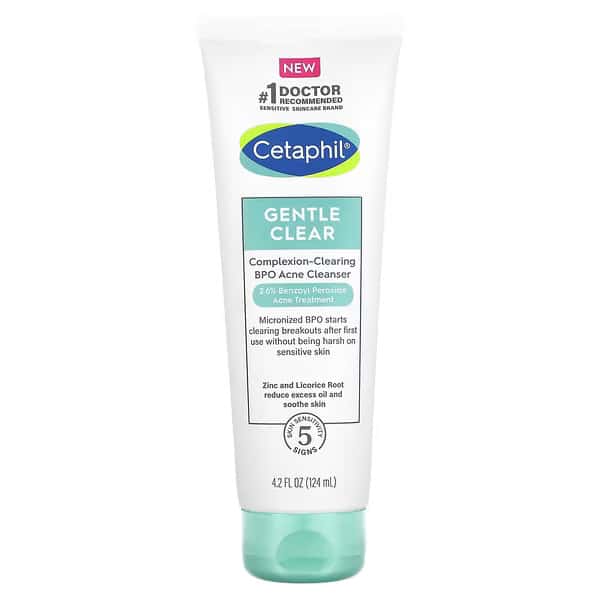1. Overview & Uses
What is Benzoyl Peroxide?
Benzoyl peroxide is a widely used over-the-counter (OTC) and prescription topical medication for treating acne. It is classified as an antibacterial and keratolytic (peeling agent) that helps unclog pores, reduce inflammation, and kill acne-causing bacteria (Propionibacterium acnes).
What is Benzoyl Peroxide Used For?
- Acne Treatment: Effective against mild to moderate acne, including pimples, cystic acne, blackheads, and whiteheads.
- Spot Treatment: Can be applied directly to active breakouts to reduce redness and swelling.
- Combination Therapy: Often used with other acne treatments like retinoids or antibiotics.
- Other Uses: It is sometimes prescribed for conditions like folliculitis and rosacea.
How Does Benzoyl Peroxide Work?
- Antibacterial Action: Kills acne-causing bacteria by introducing oxygen into clogged pores, making the environment inhospitable for bacteria.
- Exfoliation: Removes dead skin cells, preventing clogged pores.
- Oil Reduction: Reduces excess sebum, one of the main contributors to acne formation.
2. How to Use & Dosage
Proper Application of Benzoyl Peroxide
- Wash your hands before and after applying.
- Cleanse the skin with a gentle, non-medicated cleanser and pat dry.
- Apply a thin layer of benzoyl peroxide gel, cream, or lotion to the affected area.
- Rub it in gently and allow it to dry completely before applying other products.
- Avoid overuse, as this can lead to irritation and excessive dryness.
Dosage & Concentrations
- Available Strengths: 2.5%, 5%, and 10% formulations.
- Gels & Creams: Typically applied once or twice daily.
- Face Washes & Cleansers: Often used once daily or every other day, depending on skin tolerance.
- Spot Treatments: A higher concentration may be used for localized breakouts.
Missed Dose & Overuse
- Missed Dose: Apply as soon as remembered unless it’s close to the next scheduled application. Avoid double-dosing.
- Overuse Risks: Excessive application can cause severe dryness, redness, peeling, and increased sensitivity to sunlight. If irritation occurs, reduce usage frequency.
3. Application Tips & Warnings
Best Practices for Safe Use
- Avoid the Eyes & Mucous Membranes: If contact occurs, rinse thoroughly with lukewarm water.
- Sun Protection: Benzoyl peroxide increases photosensitivity; always wear sunscreen (SPF 30+) and limit sun exposure.
- Avoid Contact with Hair & Fabrics: May cause bleaching or discoloration of clothing, towels, and bedding.
Reducing Irritation & Sensitivity
- Start with a Lower Concentration: A 2.5% formulation is effective for most users while minimizing irritation.
- Gradual Introduction: Begin with every other day application and increase as tolerated.
- Moisturize Regularly: Use a non-comedogenic moisturizer to prevent excessive dryness.
When to Discontinue Use
- If severe irritation, swelling, or blisters develop, discontinue use and consult a healthcare professional.
4. Side Effects & Precautions
Common Side Effects
- Mild Irritation: Dryness, peeling, and redness may occur, especially in the first few weeks.
- Burning or Tingling Sensation: A mild warming effect is normal upon application.
Serious Side Effects (Rare but Important)
- Severe Allergic Reaction (Anaphylaxis): Symptoms include swelling, rash, difficulty breathing, or dizziness. Seek emergency medical attention immediately.
- Severe Skin Irritation: Blisters, excessive peeling, or pain require discontinuation and medical advice.
When to See a Doctor
- If irritation persists for more than four weeks.
- If acne worsens significantly.
- If signs of infection (pus, fever) develop
5. Drug & Medical Interactions
Potential Drug Interactions
- Other Acne Medications: Using benzoyl peroxide alongside retinoids (like tretinoin) may increase irritation. It is best to apply them at different times (e.g., benzoyl peroxide in the morning, retinoid at night).
- Topical Antibiotics (Clindamycin, Erythromycin): Can be safely combined but should be used under a doctor’s guidance.
Food & Drink Interactions
- No known interactions, but maintaining a balanced diet can help with overall skin health.
Who Should Not Use Benzoyl Peroxide?
- Individuals with severe allergies to peroxide-based products.
- Those with extremely sensitive or broken skin.
- Pregnant or breastfeeding women should consult their doctor before use.
6. Storage & Handling
Proper Storage
- Keep benzoyl peroxide in a cool, dry place (below 25°C or 77°F).
- Avoid exposure to direct sunlight and heat, as the compound can become unstable.
- Keep tightly closed and away from moisture (do not store in the bathroom).
Shelf Life & Disposal
- Check expiration dates before use.
- Dispose of expired or unused products in accordance with local regulations.
7. Additional Considerations
Long-Term Use & Skin Health
- Prolonged use is safe when monitored properly, but periodic assessment by a dermatologist is recommended.
- If acne persists despite benzoyl peroxide use, alternative treatments such as prescription-strength retinoids or oral medications may be necessary.
Can Benzoyl Peroxide Be Shared?
- No. Personal medications should not be shared due to potential skin reactions and different individual needs.
Final Takeaway
Benzoyl peroxide is a highly effective acne treatment when used correctly and consistently. While it has potential side effects, they are generally manageable with proper precautions. Always consult a healthcare provider if experiencing severe reactions or if acne does not improve.

